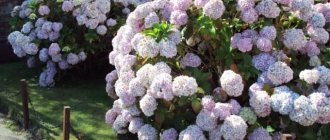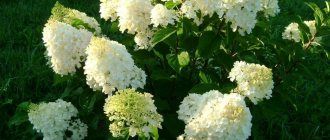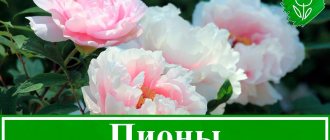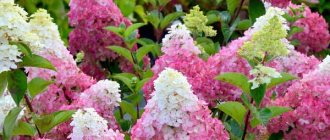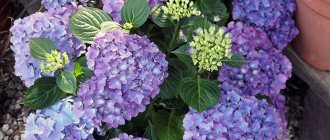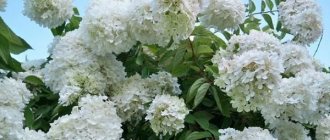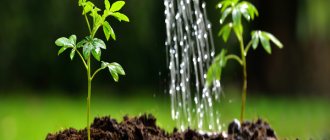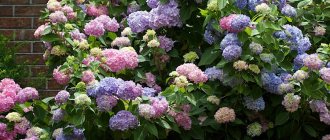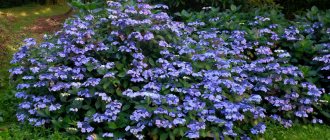According to the botanical classification, hydrangea belongs to the family of the same name. Now these flowers bloom profusely in gardens and sit majestically in pots on windowsills, looking out from the windows. Hydrangea appeared in Europe more than six centuries ago. The exotic plant was brought at different times from North America and Asia to France and England. Like any curiosity, it cost a lot of money and joined the collections of only wealthy people. In Europe, hydrangea was initially represented in only two colors: scarlet and white. Subsequently, thanks to the work of breeders, inflorescences of new colors appeared. Although hydrangea grows in vast areas of North and South America, the Russian Far East and Asia, the flower is most widespread in China and Japan. IN
The land of the rising sun gave it the name ajisai, which is translated from kanji as “purple sun flower”. The most lush thickets of hydrangea can be seen in the ancient Japanese city, one of the former capitals of the country - Kamakura. In addition to the Buddha statue and numerous Shinto shrines, there is Meigetsu-in or Ajisaydera, which translates to “Hortensia Temple.” The complex has existed since 1160 and during this time the buildings were carefully surrounded by bright blue clouds of Princess hydrangea inflorescences. At the beginning of summer, the temple turns into a huge fragrant garden that attracts tourists. Nowadays, getting such splendor for your home is not difficult. Let's learn about the vagaries of garden hydrangea, the features of its cultivation and species classification.
History of the name
The name “hydrangea” was given to the plant by Philibert Commerson, it is derived from the Latin hortus (garden). Since Hortense was a common female name in this era, many versions arose about the woman to whom this name could be dedicated: from Nicole-Reine Lepot, who could be called Hortense in the family, to Princess Hortense - the sister of Prince of the Holy Roman Empire Karl Heinrich of Nassau-Siegen .
Later, European botanists-taxonomists gave the plant the name Hydrangea, which can be translated as “vessel of water” (ancient Greek ὕδωρ - water, ἄγγος - vessel). According to one version, the name was given to hydrangea for the shape of the seed pods, reminiscent of a jug, according to another - for its moisture-loving nature.
In Japan they are called Ajisai. Writing the name of a flower in hieroglyphs can be translated as “purple solar flower”, “flower similar to the purple sun”.
White garden hydrangea spherical
Previously, shrubs could be found in almost every yard. It is unpretentious compared to other plants, so it is loved by both beginners and professional gardeners. White spherical hydrangea can be grown in the Moscow region, Siberia, the Far East and the Urals.
White spherical beauty
Origin and appearance of the plant
Hydrangea was first brought to Europe at the end of the 18th century from the island of Mauritius by members of a round-the-world expedition. The flower got a beautiful name in honor of Princess Hortense, who was the sister of Prince K. G. Nassau-Siegen.
There are two more versions of the origin of the name of the plant - in honor of the beloved woman of the French doctor F. Commerson and a translation from Latin, which means “from the garden.”
Descriptions of the flower of the plant
Most hydrangeas have lilac, pink, blue, red, cream or white flowers that are borne in panicles or “scutes.” Inflorescences can be small (fertile) with the formation of seeds after two weeks of flowering or large (sterile) with the formation of balls.
Important! Beginning flower growers often confuse hydrangea with the sterile viburnum. The difference is that hydrangea has flowers with four petals, and buldenezh is similar to a snow globe.
Unpretentious large-leaved plant
Hydrangea: plant description
Climbing hydrangea (Hydrangea scandens) Botanical illustration from the book of Siebold and Zuccarini Flora Japonica, Sectio Prima, 1870
Most species are shrubs 1-3 m tall, some species are small trees, the rest are vines that climb the trunks of other trees to a height of up to 30 m Plants can be either deciduous or evergreen, but the widely cultivated temperate zone species are deciduous.
Hydrangeas bloom from spring to late autumn. The flowers are collected at the end of the stem into beautiful spherical inflorescences - a corymb or panicle. In most species, the flower heads contain two types of flowers: small fertile flowers in the middle and large sterile flowers at the edges. In some species, all flowers are fertile and have the same size.
The vast majority of flowers are white, but some, such as bigleaf hydrangea (Hydrangea macrophylla), can be blue, red, pink and lilac. In such species, the color often depends on the pH level (hydrogen index) in the soil: in acidic soils, the petals become blue, in neutral soils - pale beige, and in alkaline soils - pink or lilac.
Hydrangeas are one of the few plants that can accumulate aluminum, which is released from acidic soils and in some species forms compounds that give them blue tints.
The fruit of hydrangea is a 2-5-part capsule with numerous small seeds.
Plants from another closely related genus, Schizophragma, are also sometimes called hydrangeas. Among climbing plants, the most famous are Schizophragma hydrangeoides and Hydrangea petiolaris.
Description and characteristics
Hydrangea or garden hydrangea is a perennial, fruit-bearing, evergreen or deciduous plant with an incredibly lush and long flowering period. Grows well in latitudes with mild climates. Most species have oval-shaped leaves with a pointed edge. The leaf blade is framed by small teeth with a pronounced central vein.
Flowering begins in spring and lasts until frost. Hydrangea inflorescences are dense, spherical, paniculate or corymbose in shape. At the same time, two types of flowers grow in inflorescences: sterile and fertile specimens, but there are rare exceptions.
Sterile (sterile) ones are larger and located at the edges of the inflorescence. Fertile (fertile) ones are small and located in the center of the inflorescences.
The color range is quite varied, the most common are plants with white, pink, burgundy, crimson and lilac flowers. The color of the inflorescences directly depends on the acidity of the soil, variety and growing conditions.
The fruits are small boxes, divided into chambers from 2 to 5 pieces. In each “pocket” seeds ripen, which are used to propagate the variety.
In nature, bush and tree hydrangeas can grow up to 3 meters. Flowering liana-like varieties under good conditions can grow up to 30 meters in height. Garden varieties are more decorative and usually do not exceed 2–4 meters. In addition to garden species, there are home varieties that grow and develop well on windowsills.
Types and varieties of hydrangea
If you are thinking about decorating your garden with hydrangea, then first of all you should pay attention to the characteristics of the different types of this plant. Then you can choose exactly those species that will be best suited for your garden.
It is also important to know how to care for each species. For example, tree or large-leaved hydrangea must be prepared for wintering and pruned somewhat differently than paniculate hydrangea. If you know a lot about the rules for caring for such plants, then caring for them will not be difficult.
Tree hydrangea (Hydrangea arborescens)
Hydrangea
This variety is very popular among gardeners living in mid-latitudes. This plant is presented in the form of a shrub. Its height can vary from 100 to 300 centimeters. Inflorescences grow on the tips of annual stems. When the flowers just begin to open, they are light green in color; after they are fully opened, they change their color to cream or white. The most popular varieties are: “Invisible Spirit” - the flowers are pink; “Sterilis” - the inflorescences are painted white, and this plant blooms very profusely; "Annabelle" and "Grandiflora" - have very large inflorescences, painted pure white (note that paniculate hydrangea has varieties with exactly the same names).
Hydrangea Annabelle
Hydrangea Anabelle
Today, this plant can often be seen in the landscape design of modern private houses or in the design of decorative street courtyards. Tree hydrangea "Annabel" is a dome-shaped deciduous shrub that is grown exclusively for decorative purposes.
Tree hydrangea Annabelle is distinguished by its relatively large size (width). The height of the plant, depending on the variety, can reach 1.5 meters, and the width - up to 3 meters. The leaves of this plant have a soft and lightweight structure, the most common color is deep green or emerald. There is no gloss on the leaves. The leaves are oval in shape, with pointed tips. The average leaf length is up to 20 cm. A large number of leaves and massive inflorescences form a lush, loose and spreading oval-type crown.
The plant blooms in June and ends flowering in late September or early October. The flowers themselves are small - up to 2 cm in diameter, but form massive, dense spherical inflorescences up to 20 cm in diameter. The colors of the flowers at the beginning of flowering are pale green; as the inflorescence matures, they acquire a soft cream or white color.
Hydrangea paniculata
Hydrangea paniculata
Under natural conditions, such a plant has the form of a tree or shrub, the height of which can vary from 2 to 5 m. This species is considered one of the most popular among gardeners. Without replanting in the same place, this type of hydrangea can grow and develop normally for more than 40 years. The stems of this plant become lignified in a relatively short time, which is why it is considered winter-hardy. Inflorescences grow in the upper parts of this year's stems, and the flowering is notable for its abundance. However, the buds formed in the last days of June open only in August or September. The inflorescences of this type of flower have a pyramidal shape. When the flowers begin to open, they are pale green in color, and after full opening they turn white. At the end of the summer they turn light pink and then brick. When the flowering period begins to end, the flowers turn light green again. The most popular varieties are Grandiflora, Quishu, Vanilla Fraze and Tardiva.
Hydrangea Vanille fraise
Hydrangea "Vanilla Fraze"
Paniculate hydrangea "Vanilla Fraze" ("Vanilla Fraise") is a perennial plant that, under favorable conditions and proper care, lives up to 50 years. The name Vanille fraise comes from two French words: the first translates as “vanilla”, and the second means “strawberry”.
The variety was created in the French nursery Renault. Work on it was carried out from 1989 to 2003. The development of “Vanilla Fraze” was carried out by the head of this institution, Eric Reno, who received several awards for it at various exhibitions.
The variety impresses first of all with its beautiful, lush and long-lasting flowering. It begins in the first half of June (in some regions even at the end of May) and lasts until the end of September and beginning of October. Wide cone-shaped inflorescences with a sharp white tip reach a length of 30 cm. The diameter of the entire crown varies from 1.5 to 2 meters. And the bush grows up to 200 cm in height.
Large leaf hydrangea (Hydrangea macrophylla)
Large leaf hydrangea
Or garden - it is often cultivated in the garden. However, some varieties can be grown in containers indoors or on the terrace. The dense leaves have a rich green color. This year's stems are herbaceous, which is why the bush does not have very high cold resistance. It is believed that the inflorescences appear on last year’s stems, since the buds for their growth are laid in the autumn, and they begin to grow in the spring. As a rule, the inflorescences have a viburnum-shaped, umbrella-shaped form; it is also called hemispherical or Japanese. The color of the flowers depends on the pH of the soil. More recently, interesting varieties have appeared: “Endless Summer” - in acidic soil - blue color, in neutral - lilac; "Renata Stanger" - blue; “Expression” and “Romance” have double flowers.
Hydrangea paniculata Samarskya Lydia
Hydrangea Samara Lydia
“Samara Lydia” is an amazingly beautiful medium-growing paniculate hydrangea. The size of an adult plant is 1.3 meters in height and 1.1 meters in width. The Samara Lydia bush cannot be confused with any other! Even in early June, when the buds are just beginning to form, it stands out like a proud admiral from the crowd of other hydrangeas with its juicy, pubescent dark green leaves against the background of reddish stems. In the fall, when the leaves of all other varieties of hydrangeas turned yellow and began to fall off, the foliage of “Samara Lydia” delights the eye with its festive decoration until the very frost, continuing to hold the title of the main decoration of the garden and park area for the variety.
The buds at the very beginning of flowering (for central Russia this is the beginning of July) are milky white with a greenish tip. Flowers change color very quickly. By the end of July they are mostly light pink in color, by mid-August they become bright pink, and by the end of summer they finally dress up in a noble deep ruby color.
Oakleaf hydrangea (Hydrangea quercifolia)
Hydrangea oakleaf
It has low frost resistance and needs good insulation for the winter. It blooms very luxuriantly and has unusually attractive leaves. It has a height of about 2 m. The length of the paniculate inflorescences is from 10 to 30 centimeters. Flowering begins in June–July, with the flowers initially white and later turning purple.
Ground cover hydrangea (Hydrangea heteromalla)
Hydrangea groundcover
Or hydrangea variegated - a winter-hardy species. Under natural conditions, the height can reach 200–300 centimeters. Often used to form a standard form. The length of dark green leaves is about 20 centimeters. The front side is smooth, and the back side is pubescent. The loose, corymbose-shaped inflorescences are initially white, and then turn pink at the end of flowering. Flowering begins in the last days of June or the first days of July. The most popular ground cover variety is Bretschneider, which blooms profusely in rather large inflorescences of a milky white color.
Gardeners also grow hydrangeas: ashen, serrated, radiant, rough, Sargent. They also grow the climbing species petiolate hydrangea, but as mentioned above, this is not a hydrangea.
How to care for hydrangea
Hydrangeas need to be watered regularly, especially in dry, hot weather. For irrigation, you should take soft water, preferably rainwater; hard water with a high proportion of lime is contraindicated for hydrangeas; if this is the kind of water in the well, just save rainwater in barrels.
If the weather is rainy and there is frequent precipitation, you need to loosen the soil around the hydrangeas at least once a week to a depth of 7-10 cm to improve root aeration.
At the end of spring, beginning of summer, fertilize the hydrangeas with diluted mullein (ratio 1:10), and two weeks later with a complete mineral fertilizer for flowering plants (for example, Fertika Lux), or make up your own fertilizer from 1 tbsp. spoons of superphosphate, 1 teaspoon of potassium and 1 teaspoon of ammonium nitrate per 10 liters of water.
In the future, there is no need to fertilize more often than once a month; it is enough to periodically mulch the soil under the bushes with humus or peat.
Changing color of hydrangeas
Many gardeners know that when hydrangeas bloom, they easily change color when the acidic composition of the soil changes. So, watering with alum gives the flowers a blue color; for this you need to dissolve 5 g of the product in 1 liter of water. Alum is sold in flower shops or pharmacies. For reference, the composition of alum: heptahydrate of aluminum and potassium salts.
In order for hydrangea flowers to change color, you need to water them with alum once a week for a month.
If the acidity of the soil is insufficient, then hydrangeas tend to acquire a pink tint, and some varieties simply lose color - they fade and become discolored. In acidic peat, the flowers take on a purple or blue tint, so you can water the bushes with peat-infused water.
To the contrary, to enhance the intensity of the pink color of hydrangea flowers, you can water them with a weak solution of potassium permanganate (potassium permanganate).
Pruning hydrangeas
Hydrangeas form dense, lush bushes, and they bloom on the shoots of the current year. Therefore, the more branches a plant has, the more magnificent the flowering will be. Heavy pruning should be carried out in the fall, after flowering along with the peduncle (drastic pruning is acceptable, especially in the case of diseases or pests, when it makes no sense to leave and try to cure diseased branches).
But young hydrangeas that have not yet formed many shoots, for better branching, need to be pruned in the spring, before the buds open, shortening them by 2-3 buds, no more (otherwise, they are greatly depleted from the abundant sap flow).
Very old hydrangea bushes (and they are long-lived plants) are renewed by pruning them at the root. In this way, bushes can be preserved for decades, not forgetting to improve the soil under them by adding humus and mulch (including leaf humus).
Young plants are ready to bloom profusely in the first year after planting. However, excessive flowering can greatly deplete hydrangeas. Therefore, on a bush about 50 cm high, it is better to leave no more than 2-3 inflorescences, and pick off the rest.
Sheltering hydrangeas for the winter
The most popular hydrangeas in our gardens are tree-like and large-leaved, they show good frost resistance. The most popular hydrangea variety “Annabelle” winters well in the Moscow region and Leningrad region without additional shelter.
Some varieties of large-leaved hydrangea of Dutch origin are somewhat more tender, like any young hydrangea grown from cuttings and layering - they must be mulched in the fall with peat, leaf soil, humus or a mixture of humus and sawdust to protect them from freezing. Cover the bushes themselves with spruce branches. But don’t forget to remove the cover in the spring to avoid damping off.
In regions with harsh winters, it is necessary to additionally cover hydrangeas for the winter with film or spunbond. With the onset of frosty weather, bend the shoots to the ground, mulch, and cover with a film of leaf litter. It is better not to use straw, because... Mice love her.
In the spring, after the snow has melted, remove the film cover, tie up the hydrangea shoots in a vertical position, but before the onset of warm days (until the threat of return frosts has passed), keep the burlap cover (damping does not occur under it).
Choosing a landing site
Hydrangea is planted in sunnier places, but so that during the day it is in partial shade, because the sun's rays can burn the leaves and flowers of hydrangea. It is better if the sun's rays hit the hydrangea in the morning or evening.
Loams are well suited for hydrangea, and the acidity of the soil should be high. The soil is constantly moist, well-drained (expanded clay and stones are usually placed at the bottom of the hole).
The plant will not do well on clay soils; stagnation of water in the soil is detrimental to it. This can be corrected by mixing the soil with peat, sand and soil on which coniferous forest previously grew.
General characteristics of hydrangeas for Russian gardens
The plant genus is part of a large group of the hydrangea family. It includes small trees and bushes. There are more than 80 species of plants in the group. Hydrangea came to Russia from Japan. The plant produces such a distinct aroma that even a single small flower will create a pleasant summer incense. For a long time, flowers decorated apartments, but breeders created species that decorated areas. Hydrangea is no longer afraid of cold climates, frosts and rains. Thanks to the work of scientists, lush buds have become popular throughout the country.
Planting hydrangea
Its further growth and flowering depends on how correctly the Hydrangea is planted. Planting material - Hydrangea seedlings, which can be purchased in gardening stores from April to September.
After purchasing seedlings, if planting is postponed for some time, they should be stored in a cool place, watered regularly, preventing the roots from drying out. Hydrangeas purchased immediately in a container can be stored for quite a long time before planting, and there are no problems with them during planting.
In central Russia and the Moscow region, it is best to plant hydrangea in the spring, since planting in the autumn threatens it with freezing and the plant will not have time to take root.
In spring, the plant is planted in the ground, when the soil has warmed up and there is no threat of frost (can be covered with covering material after planting). Planted plants require abundant regular watering. It is better to remove the formed buds.
If hydrangea bushes are planted in winter, then after planting it should not be watered often; it is necessary that they have time to take root before the winter cold. In winter, bushes need shelter to avoid freezing. Bushes that are properly planted in the fall and have taken root will bloom in the next season.
Start planting in the morning or on a cloudy day, so the plant will take root better. The hole for planting hydrangea is dug to a depth of 30 cm or to the depth of the container in which the hydrangea was purchased. The diameter of the pit is 2 times wider - 50-60 cm.
Drainage (10-12 cm) is poured into the bottom of the hole, then soil taken out of the hole and mixed with peat and sand in a ratio of 2:1:1, compost and mineral fertilizers can also be added there. The addition of organic and mineral fertilizers enriches the soil with necessary substances and creates good conditions for the development of shrubs. To make your work easier, you can add a hydrogel to the soil, thanks to which water is retained in the soil, and the plant does not need frequent watering.
Before planting, it is advisable to immerse the seedling directly in the container in a container of water; you can also add a stimulant for root formation there. After the soil gets wet, the seedling must be carefully removed from the container, being careful not to damage the root ball, so the seedling will take root better.
A mound of prepared soil is poured onto the drainage layer, a seedling is placed on it and covered with the remaining soil, then it is compacted. When planting, it is very important not to bury the root collar of the plant; it is advisable that it be at ground level. After planting, the seedling is watered abundantly, then the soil around is mulched with peat, sawdust, pine bark and other conifers. For mulch, ground cover plants with shallow roots are planted around the hydrangea.
The distance between hydrangea bushes when planting several pieces should be at least 0.8-1 meters.
Planting a plant in open ground
Selecting a location
Hydrangea is a very capricious crop, so its location in the garden plot is of great importance for normal growth.
The basic requirements for the landing site are as follows:
- Good lighting. Hydrangea is predominantly light-loving, so if planted in the shade, it will suffer, with the inflorescences shredding, and may even die. It is advisable that at noon (from 12 to 15 o'clock) the seedlings are partially shaded, and the rest of the time they are brightly lit. However, tree, groundcover, Sargent and rough varieties can grow in partial shade. In the northern regions, the place should be illuminated as much as possible in the middle of the day.
- Protection from wind and drafts. It is better to plant an ornamental crop in the southern part of the site, so that on one side it is covered by a house wall, a fence or taller shrubs. But at the same time, these objects should not shade it from the sun.
- Deep groundwater (at least 1.5 m) and the absence of lowlands. If soil water is close, flower beds are organized with their elevation above the ground 50 cm or higher, but this leads to additional watering of the flowers.
- Remoteness from trees and shrubs with a shallow root system, since in the future they will compete for moisture and nutrients.
- Lack of washbasins, outdoor showers, etc., which affect the formation of an alkaline environment.
A significant factor for a flower is its environment in the form of garden crops. Some of them have a beneficial effect on him, while others can cause harm. Useful neighbors for hydrangea are perennial flower species - peonies, irises, roses, hostas and others, and vegetables - zucchini and cucumbers.
It is undesirable to grow close to black currants, white acacia, herbs and garlic.
Soil preparation
Soil plays a very important role for the proper growth and flowering of hydrangeas. Therefore, this issue should be approached carefully. To grow the crop, it is necessary to use loose, well-watered and breathable soil, enriched with organic matter. It should be neutral or slightly acidic (pH 5.5-6.5). If the soil is alkaline, it is acidified using a layer of peat or a special product “Acid Plus”. Acidic soil must be neutralized with dolomite flour (2kg/5m2 area).
It is advisable to carry out all preparatory operations in the fall. If they are transferred to the spring, 3 weeks before planting.
Boarding order
The hole for planting is made 2 times larger than the volume of the root along with a lump of earth with it (on average about 40 cm). Native soil is selected from it, and a drainage of crushed stone or broken brick about 10 cm high is laid at the bottom. Next, the space is filled with a substance from the upper fertile layer, peat, rotted manure, leaf turf and sand in equal proportions.
Additionally, mineral and organic fertilizers :
- superphosphate - 2 tbsp. spoons;
- potassium sulfate - 1.5 tbsp. spoons;
- wood ash - ¼ bucket.
Then the roots of the seedling are leveled, they are shaken off a little and buried in a mixture of soil and compost. In this case, the upper part of its root system should be slightly on the surface (transparent).
At the next stage, the soil is compacted, watered and mulched (with peat chips, sawdust, bark or pine needles). This helps retain moisture and prevents weed growth.
Interesting! Large-leaved hydrangea is a unique plant, the color of which depends not only on the variety, but also on the acid-base balance of the soil.
To obtain blue shades of the flower, it is enough to acidify the soil with a solution of citric acid or Blue Hydrangea fertilizer. When adding crushed chalk or 1.5 cups of dolomite flour, the color becomes pink, lilac or red. A neutral environment affects the appearance of white or beige color.
When applying the indicated compositions from different sides of the bush, you can observe different shades of inflorescences. However, such experiments should be carried out with mature shrubs (over two years old).
Aftercare
After planting hydrangea, the gardener needs to carry out a set of simple but mandatory agrotechnical measures.
Watering hydrangea
Regular moistening of the plant is one of the important nuances that ensures proper growth and flowering. In the summer months, during intense heat, it is recommended to water the plant at least 2-3 times a week. For an adult hydrangea, the optimal amount of liquid will be a volume of water of 30-50 liters.
Water for irrigation should be prepared in advance so that the liquid is warm and settled, especially if tap water is used. A layer of mulch will retain moisture in the soil for several days.
Watering hydrangea
Top dressing
The introduction of important fertilizers will allow you to have a profusely flowering and healthy crop on the site. Therefore, after planting and applying the first part of fertilizing, after rooting, the introduction of organic complexes should be carried out at least twice a year. The first group of fertilizers is usually applied during the flowering phase of the hydrangea, the second part will be needed by the plant after it has flowered, that is, in the fall. In spring, it is recommended to use a liquid fortified composition based on urea at the rate of 2 grams of the substance per 1 liter of water.
For one adult plant in the spring you will need to use at least 25 liters of such liquid fertilizer.
Some gardeners additionally feed hydrangea in the summer - during this period, slurry is usually used as a top dressing. In autumn, complex formulations are used for flowering garden crops.
A flower such as hydrangea has a unique feature of changing the color of its inflorescences when adjusting the acid-base balance of the soil. To change color, alkali (lime, dolomite flour) is used, giving the flowers red and pink shades. Soil with a neutral pH will allow the site to have crops with white or cream-colored flowers.
Trimming
Pruning different types of hydrangea
Most hydrangea varieties require pruning when they reach 3 or 4 years of age. The essence of the work is to trim the stems on which flowering will occur this season. As a rule, this work is carried out in the spring, but before the first buds appear. In addition, it is important to choose the moment to trim the crop before the juices begin to flow in order to avoid the death of the plant.
The longest shoots are subject to shortening. As a rule, paniculate, tree-like, variegated, creeping and herbaceous crops are pruned, shortening the branches by one third.
Some viable material can be used to propagate the crop from cuttings.
Hydrangea also requires sanitary pruning in the fall. During this period, work should be carried out carefully, without removing too much of the healthy branches, but damaged or dried areas should be separated from the plant entirely.
Medicinal properties
Medicinal properties are known to official medicine. In the Caucasus, hydrangea is specially grown for medicinal purposes.
- The beneficial substances contained in it help with diseases of the genitourinary system and kidneys, skin pustular rashes, and diabetes.
- When the removal of water from the body is impaired, it acts as a cleanser and is also used as a choleretic agent.
- Biological active substances contained in hydrangea are used in the complex treatment of dyspepsia, dropsy, scurvy, paralysis, etc. Of course, before using hydrangea tinctures and decoctions on your own, you need to consult your doctor.
Hydrangea propagation
Hydrangea propagation by cuttings
There are several ways to propagate hydrangeas - cuttings, dividing the bush and layering. If there was no such plant on the site before, you will need to buy ready-made seedlings. It is best to start in the spring so that the flower has time to take root well in the first year, without the threat of frost.
- Cuttings are only suitable for large-leaf hydrangeas, since they are the most compact. For this purpose, in the fall (October-early November), the parent bush is transplanted from the street into a pot and left in a cold place (from 0 to + 2C). From January, the temperature around the plant should rise to +10C. In February, cuttings ripen on the shoots, from which the lower leaves are removed, the cut site is treated with a growth stimulant and planted on this side in a nutritious soil mixture, covering the top with a jar or bottle to create a greenhouse effect. After rooting, the cutting can be moved to a permanent place.
- Young annual shoots are rooted by layering, digging them into the ground in the fall without separating them from the bush. You need to leave a tip at least 20 cm long on top. After 5-6 months, the shoot is cut off from the mother plant and replanted.
- The division of the bush is also done in spring or autumn, and each part must have strong roots. The sowing method of propagation is rarely used; this is mainly done by breeders. It takes 2 years to grow hydrangea from seeds to seedlings.
What to plant next to hydrangea - choosing partners and companions
Hydrangeas go well with lilac bushes. Large inflorescences of plants harmonize with each other, emphasizing the splendor and even slight solemnity of the design. Small flowers of spirea and mock orange are another option for adding hydrangea brushes. Since all species are moisture-loving, the bushes can be planted near a pond. In this zone they are combined with thickets of bergenia and astilbe. Another option for group planting is to combine it with other shrubs as part of a hedge (boxwood, cotoneaster, juniper). You can experiment and plant hydrangea next to flowers of “royal blood”: lilies or roses. For a weaving species, clematis or ivy are suitable as a neighbor.
Diseases and pests
Although hydrangeas rarely cause problems, they can be attacked by several diseases and pests. Proper fertilizer and conditions in the growing area are very important for their health. Hydrangea diseases usually appear as a result of improper care. For healthy growth, bushes should be planted in lightly shaded positions, in areas with fertile, humus-rich, fairly moist soil with a slightly acidic to acidic pH.
Chlorosis
In soils with too high a pH, hydrangea develops leaf chlorosis, which manifests itself in a light color or yellowing of their tissues. Leaf veins remain dark green during chlorosis.
In case of leaf chlorosis, an acidifying soil fertilizer should be used (it is better to enrich the soil with acidic peat). Chlorosis can be prevented by using hydrangea fertilizers that contain all the macro- and microelements necessary for this plant, but with a low calcium content. The soil under the bushes should also be mulched with pine bark, which is also acidic and slowly decomposes, helping to maintain the soil pH lower. Pine bark also plays a decorative role. Iron chelates are very effective for chlorosis.
Sunburn of leaves
Sometimes hydrangea leaves can burn. In hot and sunny weather, the leaves located on the outside of the bush become yellow or brown, and some fall off. Hydrangeas are shade-tolerant plants, their leaves are sensitive to excess sun, so they can be damaged in very sunny places, on too dry soil. To prevent the leaves from burning, the plant should be given more shade and watered regularly.
Gray mold
The cause of another hydrangea disease, called gray mold, is overwintering the plant in the wrong conditions. Frequent rainfall and dense planting of shrubs also contribute to the development of this disease. Gray mold, caused by the fungus Botrytis cinerea, leads to rotting of buds and flowers, and death of the tips of shoots or individual leaves. The youngest leaves turn black and the rot spreads to the stem. The tops of old leaves turn brown and black. Some flowers may turn brown, and a gray coating of mycelium and spores appears on their surface. Infected parts of plants must be cut off and burned. For spraying, when fighting gray mold, fungicides are used:
- Topsin M 500 SC,
- Captan.
Leaf spot
When affected by this disease, spots of varying sizes appear on hydrangea leaves, usually round, first light brown, then brown and gray-brown, often surrounded by a red border. The leaves die.
To prevent the development of the disease, you need to avoid:
- excessive thickening of plants;
- wetting the leaves during watering (you need to water the soil).
The first leaves with spots should be removed and burned. In autumn, all fallen leaves should be raked to prevent them from becoming a source of infection in the following season. Affected leaves should not be put into compost; it is better to burn them.
In late autumn, the bushes should be sprayed with 1% rapeseed oil. If there are a lot of infected leaves during the growing season, it is necessary to use fungicides:
- Dithane NeoTec 75 WG),
- Systemik 125 SL,
- Topsin (Topsin M 500 SC).
Spraying is repeated 2-3 times with an interval of 7-10 days, using 2 alternating preparations.
Powdery mildew
The most dangerous is powdery mildew caused by the fungus Erysiphe polygoni, whose mycelium in the form of a powdery coating first appears on stems and inflorescences, causing them to die. Initially, the disease manifests itself in spots; over time, plaque can cover the entire leaf blade. Over time, the surface of the leaves becomes covered with a brownish coating. Infected leaves grow more slowly, and the apical shoots are deformed.
Having noticed the first symptoms, you need to remove the infected parts of the plant, and in the fall, carefully collect fallen leaves so that they do not become a source of infection in the next season. For spraying, the same fungicides are used as for controlling spotting. You can also use sulfur preparations.
Pests
Spider mites on hydrangea
Hydrangea may suffer from pest attacks, but they do not cause significant damage. Only two pests can be found on hydrangeas - aphids and spider mites.
- Sometimes aphids appear on hydrangeas. Aphids can be observed mainly on the tips of shoots and on the undersides of leaves, where they form large clusters of dark green to black wingless insects. Aphids sucking plant sap limit the growth of shoots and cause deformation of leaves and inflorescences. Insects secrete sticky honeydew, which contributes to the formation of a black fungal coating. For aphids, the bush is sprayed with insecticides - Pirimor (Pirimor 500 WG), Provado (Provado Plus AE).
- Spider mites feed on the undersides of hydrangea leaves from May to mid-August. The mite sucks the sap of leaves, causing yellow mosaic discolorations to form on the leaf surface. Initially, the spots appear along the veins of the leaves, then they can cover the entire surface of the leaf blade. Severely infected leaves turn yellow, brown at the ends, and fall off. To combat spider mites, you should use the drug Karate Zeon 050 CS.
Hydrangea blossom
Garden hydrangeas are grown for their large inflorescences collected in a shield, umbrella or panicle. Their shape depends on the type and variety, it happens:
- spherical;
- hemispherical;
- flat;
- pyramidal.
Bush hydrangea has two types of flowers:
- The fruiting (fertile) ones, on which the seeds are set, are small, often inconspicuous. Usually located in the center of a flat shield, or inside a panicle or sphere.
- Sterile (sterile) - large, with 4-5 petals, do not produce seeds, but attract pollinating insects. They are conspicuous and located on the outside.
It is the sterile flowers that determine the density of the shields or panicles, reaching 15-25, and sometimes more than 30 cm. In species of garden hydrangeas, they are usually white or pink; varieties can be cream-colored, light green, from lilac and lilac to rich red and burgundy. Often, when the buds begin to open and when they wilt, the flowers acquire a greenish tint. Recently, breeders have come close to creating yellow cultivars.
The blue, blue, and purple color of garden hydrangea is not natural, but is achieved by adding special preparations.
There are double and semi-double varieties, with uneven coloring. There may be a border along the edge of the petals, and a peephole in the center.
In an inflorescence, the buds do not bloom simultaneously, but from the base to the top. This is especially noticeable in the photo of Hydrangea paniculata hydrangeas. As they bloom and wilt, the color changes.
Depending on the species, garden hydrangea blooms on the growth of the current or last year. This feature must be taken into account when pruning so as not to remove excess. There are varieties that open buds from summer to late autumn, from 1-1.5 to 4 months for different species.
The size of the inflorescences can be adjusted by pruning - the fewer shoots left on the bush, the larger the caps will be. A free-growing hydrangea with proper care will produce many small flowers.
Application in landscape design
Hydrangea is a favorite among flowering shrubs and is widely used in landscaping.
Various shapes, colors and long flowering periods attract the attention of both professional designers and ordinary gardeners.
In Russian latitudes, paniculate, petiolate and tree hydrangeas are most often grown.
On the Internet you can find the most unusual photos of hydrangeas, which are used to create flower beds, hedges and design rock gardens.
You can emphasize the beauty of perennial bush hydrangeas with different types of blue or lilac aquilegia, spirea or other ornamental plants. But orange, yellow or red flowers are not the most suitable combination. Blue flowers, coniferous perennials or low-growing hostas are best.
Hydrangea is a rather lush plant, so designers recommend planting it in the background.
It is better to plant aubrieta, microbiota or spherical, dwarf thujas in the foreground in the garden landscape.
Climbing varieties decorate gazebos, arches, and mesh fences. They go perfectly with delicate annual flowers, ornamental grapes and other plants.
Garden and large-leaved hydrangeas grow well indoors. The remaining varieties are best grown in open ground, as they are more impressive in size.
Preparing hydrangea for winter
A fairly warm and snowy winter period allows even species that love warmth (serrated and large-leaved hydrangea) to overwinter without shelter. However, it should be taken into account that the winter will be frosty or warm; no one knows exactly how much snow will fall.
It is better to play it safe and, despite the fact that weather forecasters promise a warm winter, prepare the plants for wintering properly. Because if the forecast of weather forecasters is incorrect, then plants unprepared for wintering may die.
When is the best time to cover this flower and how to do it? As a rule, this procedure is carried out in October, after the first frosts have passed.
Preparing hydrangea for winter
If the bushes are young, then they should be covered to the top with dry soil. Grown bushes must be pressed to the surface of the soil and covered with roofing felt or lutrasil. They must be secured with bricks, since such a shelter can be blown away by the wind.
Older bushes will require more effort. The bush must be carefully tied and then covered with spunbond or lutrasil. After this, a metal mesh frame should be created around the bush, which should have a cylindrical shape. In this case, the walls of the structure should be 20–25 centimeters away from the bush, and they should also rise above it by 10 centimeters.
The empty space in the structure should be filled with dry leaves. In spring (April), the mesh with leaves can be removed, but the spunbond is removed only after the threat of frost has passed.
You yourself can decide whether to cover these flowers for you or not. The options presented above are ideal for frosty winters with scanty snow cover. If the place where you live has a very mild winter, then covering the hydrangea can be done quite easily. And if you have winter-hardy species growing, then you don’t have to cover them at all.
However, if winters where you live are often frosty, then it is better to take care of shelter for hydrangea in the autumn and then you will be sure that it can survive even severe frosts.
Sources and literature
Sources and literature
- Botany. Encyclopedia “All the Plants of the World”: Trans. from English (ed. Grigoriev D. et al.), 2006 (Russian edition). - pp. 456-459.
- Krasavtseva A. The power of beauty // Harmony of the Garden: magazine. - September 2008. - pp. 28-32.
- Tolstaya E. Hydrangeas. Experience of growing in the Moscow region // Garden & kindergarten: magazine. - 2007. - No. 5(15).
- Tsvelev N.N. The hydrangea family (Hydrangeaceae) // Plant Life. - T. 5, part 2. - M.: Education, 1981. - P. 154-155
- Dr. D. G. Hessayon "All About Houseplants." - M.: OOO Publishing House "Kladez-Books", 2001. - 256 p.
- Fomin E. M. Hydrangea. - M.: Kolos, 1967. - 40 p.
- Description of hydrangea on the Wikipedia website ru.wikipedia.org.
Wintering
Before covering, it is necessary to tear off all the flowers on the garden hydrangea, as well as remove weak or broken shoots.
Some varieties of hydrangea are recommended to be pruned or tied. This will help preserve the branches during snowfall and rain.
The root ring is hilled up and covered tightly with mulch. Since even in frost-resistant species, the root system is close to the surface and can freeze.
Young and heat-loving plants are bent to the ground and covered with earth. Additionally covered with roofing felt or covering material.
Experienced gardeners recommend covering plants with a metal frame in the shape of a cylinder. The empty space around the bush is filled with dry leaves or other insulation. The top of the structure is covered with covering material.
Pots with home flowers must be brought indoors. If you leave them outside, the root system will freeze and the hydrangea will die.
